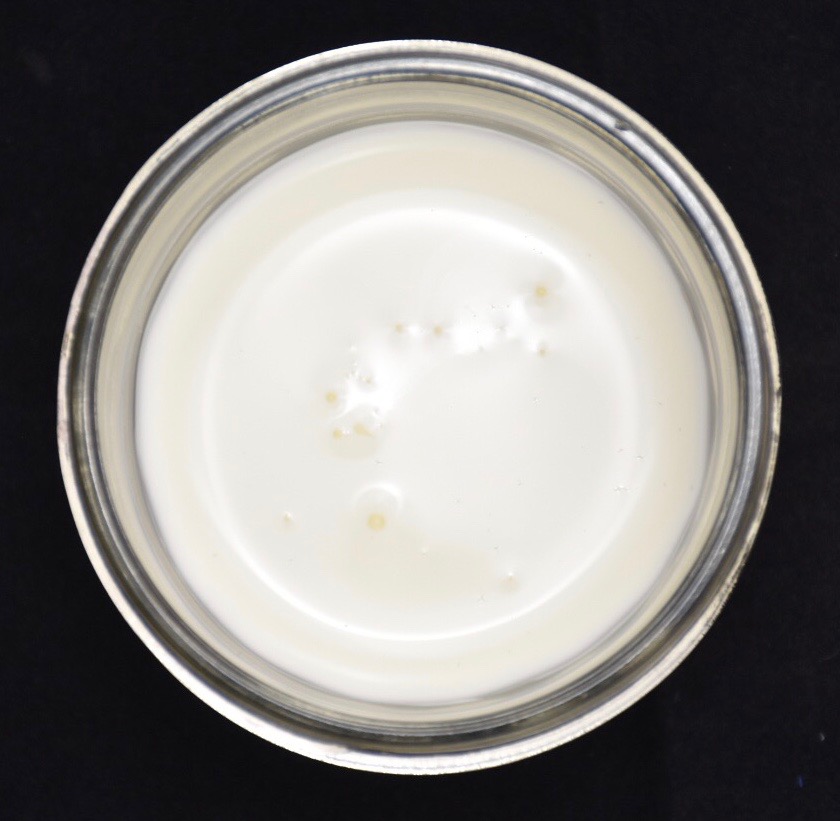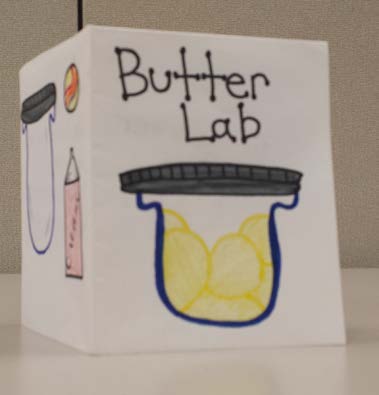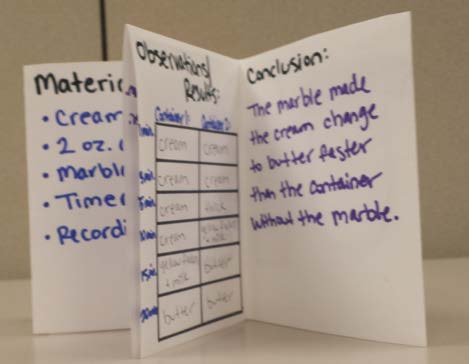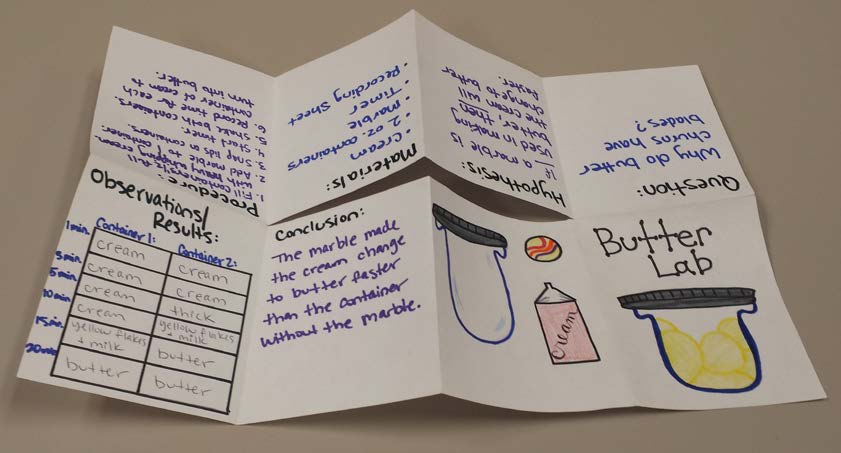 Relevancy and Engagement
dc.agclassroom.org
Relevancy and Engagement
dc.agclassroom.org
Whipping Butter into Shape
Grade Level
Purpose
Students investigate the physical change that occurs as milk is turned into butter. Grades 3-5
Estimated Time
Materials Needed
Activity 1: Making Butter
- Making Butter Observation Sheet
- Heavy whipping cream at room temperature
- Baby food jars or small jam jars, 1 per group
- Timer, 1 per group
- Kitchen scale
- Butter knife, 1 per group
- Crackers
- Glass bowl
- Microwave
- Hand mixer
Activity 2: Changing Variables
- Collection of items to create a variable change (various sizes of containers, various types of milk, marbles, microwave, ice, etc.)
- 11 x 17 white paper, 1 per student
Vocabulary
buttermilk: the liquid that is left after butter has been made from milk or cream
chemical change: a change that results in the formation of a new chemical substance through the making or breaking of bonds between atoms
churn: to make (butter) by stirring or shaking cream
colloid: a substance in which particles of one substance are dispersed through another substance
emulsion: a mixture of liquids in which small drops of one liquid are mixed throughout another liquid
homogenization: the process of reducing the size of fat globules in milk to extremely small particles so the cream does not separate from the milk
physical change: a change in a substance that does not alter its chemical identity, including changes in shape, physical state, size, or temperature; this type of change is usually reversible
Did You Know?
- It takes 2.5 gallons (21.8) pounds) of whole milk to make 1 pound of butter.1
- On opening day of the Minnesota State Fair, the state dairy princess, known as Princess Kay of the Milky Way, has her likeness carved in a 90-pound block of Grade A butter.1
- Butter is most frequently made from cow's milk, but can also be made from the milk of other animals including sheep, goats, and buffalo.2
Background Agricultural Connections
Fresh milk is a mixture of cream and milk. The cream is less dense than the milk causing it to separate and rise to the top where it can be skimmed off. The milk left behind is called skim or fat-free milk. When fresh milk is taken from the dairy farm to a milk processing plant, it is separated from the cream in order to mix the precise amount of cream and milk to make 1%, 2% or whole milk. This process is called standardization. To accelerate the separation of cream from milk on a large scale, dairy processing plants use a machine called a centrifugal separator to help with this process.
Milk purchased from a grocery store does not separate. This is possible due to a process called homogenization. Homogenization shears the fat globules in the cream into smaller pieces making the milk and cream the same density so it does not separate.
Butter is a dairy product made by churning cream to separate the buttermilk from the butterfat. Heavy cream is an emulsion. Tiny globules of fat are suspended in a watery solution. Churning the cream forces the fat globules to slam into one another. If they hit each other with enough force, they will stick together eventually forming a chunk of butter. After removing the butter, a watery liquid will remain with small butter grains floating in it. This liquid is called buttermilk. The butter is rinsed, pressed, and kneaded to remove any remaining pockets of buttermilk or water. Butter remains a solid when refrigerated, softens to a spreadable consistency at room temperature, and melts to a liquid consistency at 32-35°C (90-95°F).
A chemical change is a change that results in the formation of a new chemical substance through the making or breaking of bonds between atoms. A chemical change creates a new chemical substance that typically has different physical properties when compared to the original substance. When a substance has undergone a chemical change, the process cannot be reversed. A physical change is a change from one state (solid, liquid, or gas) to another without altering the chemical composition of a substance. When a substance has undergone a physical change, the process can be reversed.
Three basic states of matter found on Earth are solid, liquid, and gas. The term, colloid, describes a substance that is a combination of different states. Colloids are made of tiny particles of solid, drops of liquid, or bubbles of gas that are evenly distributed throughout a liquid. They are not dissolved in the liquid and do not settle to the bottom or float to the top. Emulsions and foam are two types of colloids. Milk and cream are emulsion colloids with tiny globules of fat thoroughly mixed throughout water. Whipped cream is a foam colloid with tiny air bubbles thoroughly mixed throughout liquid cream.
Turning milk into butter is a physical change because the milk is changed from a colloid (cream) to a solid (butter) without altering its chemical composition. This physical change is reversible. The butter can be melted and mixed with the leftover buttermilk to make cream again.
Engage
- Ask the students to identify products made from milk. Examples include milk, butter, cheese, yogurt, cottage cheese, sour cream, ice cream, whipped cream, pudding, and cream cheese. List the items on the board.
- Explain to the students that all of these products begin on a dairy farm. Take the class on a virtual field trip to a dairy farm by viewing the video From a Farm Family Near You: Bohnert Dairy Farm.
Explore and Explain
Activity 1: Making Butter
- Organize students into small groups. Provide each group
 with a small jar, heavy whipping cream, a timer, access to a kitchen scale, crackers, and a butter knife.
with a small jar, heavy whipping cream, a timer, access to a kitchen scale, crackers, and a butter knife. - Each group should weigh their empty jar with the lid and record the weight on their Making Butter Observation Sheets.
- Instruct the groups to pour the whipping cream into the jars until each jar is half full. Have the students note the appearance and consistency of the cream and record their observations. The groups should seal the lids tightly, weigh the jar, and the record the weight.
- Tell the groups to start their timers and begin shaking the jars. Group members should take turns shaking. You may choose to
 play music to encourage the movement.
play music to encourage the movement. - Instruct the groups to stop shaking, pause their timers, and observe the contents of their jar every two minutes. Have them note the appearance and consistency of the cream and how it is changing on their observation sheets.
- The groups should stop their timers and record the time when the solid butter has separated from the buttermilk. It will take 4-10 minutes to get to this point.
- Allow time for the groups to weigh their jar of butter and buttermilk with the lid. Record the weight. Ask students to compare the weight of the heavy whipping cream to the weight
 of the butter and buttermilk. Did the weight change? Explain to the students that the weight of matter stays the same when it changes form.
of the butter and buttermilk. Did the weight change? Explain to the students that the weight of matter stays the same when it changes form. - Have the students spread their freshly made butter onto the crackers for a taste test.
- Use the Background Agricultural Connections section of this lesson to discuss the difference between chemical and physical changes. Ask the students, "Is turning cream into butter a chemical change or a physical change and why?" (It is a physical change because the change did not alter the chemical composition of the cream.) "What factor caused the physical change?" (churning) "What states of matter were observed during the different stages of the butter-making process?" (The cream is a colloid. When it is churned, it first turns into a foam (whipping cream) and then separates into a solid (butter) and a liquid (buttermilk).)
- Remind students that physical changes are reversible. Demonstrate the process of changing butter back into cream. In a microwave, melt the butter in a glass bowl. Pour in the buttermilk that was leftover from making the butter. Use a hand mixer to beat the mixture until it reaches the consistency of cream.
Activity 2: Changing Variables
- Discuss the idea that changing variables when making butter
 may affect the outcome. Temperature, time, container size, types of milk, and the addition of an agitator like a marble are examples of variables that can be tested.
may affect the outcome. Temperature, time, container size, types of milk, and the addition of an agitator like a marble are examples of variables that can be tested. - Place students back into the same groups from Activity 1. Show the students the materials you collected for changing variables. Explain to the class that each group will develop a question and hypothesis regarding how a variable change might affect the butter-making process. Limited to the materials in front of them, the groups will plan and carry out an investigation to test how a changed variable affects the outcome of the butter.
- Hand out an 11 x 17 piece of white paper to each student. Have
 each student create a foldable booklet for recording their data and observations and sharing their groups' findings.
each student create a foldable booklet for recording their data and observations and sharing their groups' findings. - Fold the paper in half vertically (hot dog fold) and crease.
- Open the paper to the original size and fold in half horizontally (hamburger fold) and crease. Fold each side up from the opening to the middle and crease. The page should be folded to show impressions for eight identical pages.
- Cut or tear the center crease line from the middle fold to the first crease.
- Open and fold like an accordion to make a continuous book.
- Write the title of your group's investigation on the front cover. Label each page in order—Question, Hypothesis, Procedure, Observations/Results, Conclusion. The back cover can be left blank or decorated.
- After the investigations and booklets are completed, have each group share a summary of their group's investigation with the class.

Elaborate
-
Discover how butter is made in large quantities to be sold in grocery stores by viewing the video How It's Made: Butter.
Evaluate
After conducting these activities, summarize the following key points:
- Milk, typically produced by cows, is used to make butter, cheese, ice cream, yogurt, and other dairy products.
- A physical change takes place when a substance changes from one state (liquid, solid, or gas) to another state without altering the chemical composition of the substance.
- Changing milk to butter is a physical change.
Sources
- https://www.midwestdairy.com/fact-sheet-butter-sculpting
- http://www.fao.org/waicent/faoinfo/economic/faodef/fdef18e.htm
Acknowledgements
Activity 2 adapted from Virginia Agriculture in the Classroom